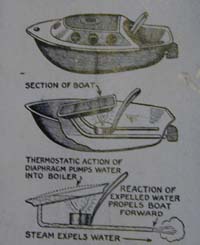Note: This article was originally published in March 2005
In addition to old patents, there is more recent technical information toward the bottom of this page.
Mr. Joel Rosenberg--whom we can all thank for finding and making these patents available as PDF documents--works with Boston's Museum of Science. He and others are developing a wide-ranging high school engineering program called Engineering the Future that includes students making putt putt boats.
The patents are in the public domain. I have added some commentary along with the links.
Thomas Piot's 1891 patent(PDF here) started it all. As he says, "My said invention is especially useful in the case of toy boats..." We can only guess about how he first came up with the idea. Did he observe something that led him serendipitously to the invention? The first two pages demonstrate a strong sense of science, so whatever triggered it, the development was still no easy accident. The third page shows pictures.
Those of us who have struggled to make putt putt engines--knowing it is possible--stand in awe of this man who made them without seeing somebody else's design! We stand on the shoulders of giants, but occasionally lightning strikes and someone invents something completely new. Let us pay our respects to Thomas Piot! Here is the best page I know of with biographical information about Désirée Thomas Piot.
Charles McHugh's 1915 patent(PDF) which was the first step to another patent of his 11 years later (see below). McHugh discovers that, "In some cases, if the boiler top is quite thin, a sound producer is provided for creating an interesting illusion.." He has discovered that by incorporating a diaphragm into the boiler he creates that wonderful sound that adds so much to the putt putt experience!
William Purcell's 1920 patent(PDF) appears to be the start of the other kind of putt putt boat: a boiler of coiled tubing. This kind of engine is very simple and durable. For years it was the only do-it-yourself putt putt engine. However, it does not make as much sound or go as fast as the diaphragm kind. Purcel realized it might be most practical to power toy boats with it, but the patent seems to leave open the possibility that it might be scaled up for a big boat. His sentiments are echoed in virtually all my classes, where someone will express an interest in a giant putt putt engine to power a full-size boat.
Charles McHugh's 1926 patent(PDF) further developed the engine to commercially viable design that could be produced in quantity. Notice how 9 years later the whole design is actually somewhat simpler. From the text and illustrations we can appreciate all the work that Charles McHugh and his partner Durward Williams devoted to making the engine what it is today. When I have some time, I would love to research how their company did.
Paul Jones' 1935 patent really emphasizes the mass-production using various stamp presses. The pressed-together parts seem to be more durable--less dependent on solder not melting. I have a Paul Jones boat in a balsa wood hull that still works well.
Interestingly, on page two Jones describes the top and bottom of the engine as "...having a different co-efficient of expansion and contraction..." Thermostats at that time were made of "bimetallic strips," which were strips of two metals stuck together. As the strips got hotter, the metals would expand at different rates, which caused the unit to bend (completing an electrical circuit). I think my all-aluminum boiler shows that it is hydraulics that make the engine work, not different rates of expansion of metals.
 Another interesting thing is the timing of the patent application: 1934. The illustration on the right is from a science publication of 1933 featuring a toy boat manufactured and imported from Japan. You can see a PDF file of the whole page here. The text which accompanies the illustration has the same incorrect assumption about variable bimetallic expansion making it work. That and a very similar-looking engine make me wonder how much the Japanese design influenced the Paul Jones patent.
Another interesting thing is the timing of the patent application: 1934. The illustration on the right is from a science publication of 1933 featuring a toy boat manufactured and imported from Japan. You can see a PDF file of the whole page here. The text which accompanies the illustration has the same incorrect assumption about variable bimetallic expansion making it work. That and a very similar-looking engine make me wonder how much the Japanese design influenced the Paul Jones patent.
Recent Developments
Dr. Jeff Bindon has developed a very clever engine that allows you to see what's going on inside. You can read more about it, here. Be sure to see his excellent article about pop pop engine design.
Dr. Guus Flogel of the Netherlands has created instructions for the most extraordinary coil-type pop pop boats made from traditional Dutch wooden shoes.You can see instructions for them here.
If it is technical information you want, Mr. Jean-Yves of France has addressed the issue of efficiency in a must-read article here. You can also see more of Jean-Yves' work here.
Mr. Rosenberg also uncovered some very technical articles for engineers about putt putt boats, including such topics as scaling the engines larger. I cannot post these on the web because of copyright. If you contact me I can direct you toward them.
